The Seaweed and Integrated Multi-Trophic Aquaculture (IMTA) Research Laboratory of
Dr. Thierry Chopin

Thierry Chopin participates in the 2010 Canadian Chefs’ Congress
September 10-12, 2010
I was very fortunate to have been invited to the second edition of the Canadian Chefs’ Congress (CCC), a biennial gathering of approximately 500 Chefs from across Canada to reinforce the passion and integrity of Canadian Food Culture. This year the CCC was held at Providence Farm, in Duncan, British Columbia, on September 10-12, 2010, and the theme was "Oceans for Tomorrow".
I really enjoyed the event and the good discussions I had with many people. Of course, I also very much enjoyed all of the delicious food! The CCC was indeed different from the type of conferences I generally attend, but I realize more and more that it is important to go out of the Science Ivory Tower, in which we can be so comfortably accustomed and maintained. The CCC was quite a treat: under the organization of Executive Chef Robert Clark (C Restaurant, Vancouver), it was a mix of grand “mass” of excellent food, wine, beer and cider; a great place for some good exchanges with a different audience (at least for me!); and a flavour in between a gargantuan Rabelaisian feast and a kind of Woodstock of Food (even rain was included!)… some people not hesitating to talk about Foodstock!
I was very pleased to note that at the “Best of the Country” lunch on Saturday, the two booths with the longest line-ups were New Brunswick and Québec. Executive Chef Jesse Vergen, from the Saint John Ale House, had prepared some of our less conventional, but no less delicious, New Brunswick seafood: a wonderful IMTA kelp (Saccharina latissima) salad (kelps marinated in a ponzu sauce made with a dashi broth of kelp, dulse (Palmaria palmata) and smoked sturgeon), dried dulse, pan fried dulse in duck fat, caviar and periwinkles. Chefs Charles and Jennifer Part, from Les Fougères in Chelsea, prepared what would be too simple to describe as “baked beans” (amazing organic Great Northern white beans with homemade wild boar bacon, homemade duck sausage, Quèbec goose, duck and ham hock, white wine, local beer, local maple syrup, fresh thyme, and garnished with seared Quèbec foie gras). I believe that the originality is what attracted people to the New Brunswick booth. Yes, you can do delicious things with seaweeds, and the way we produce them through IMTA deserves to be talked about.
I put myself at the end of the New Brunswick booth, talking to people about IMTA once they had been deliciously surprised by this IMTA kelp salad. “Wow, I had no idea kelps could be that tasty”, “Well, now that you like these kelps, let’s talk about how they have been produced… let’s talk IMTA”, and a very interesting discussion generally ensued. “Wow, I had no idea that aquaculture practices were evolving, that is quite something, let’s keep in touch”.
I also really enjoyed the one hour I had on Sunday morning, in the St. Anne Building, to explain IMTA at length and with the support of a PowerPoint presentation. I was able to go beyond the natural sciences to also consider the bigger economic and societal perspectives and implications, in Canada and beyond. I had some good discussions and feedback at the end of my presentation (people appreciated that I put my comments in the bigger perspective and made them think more globally about the issues associated with securing our food).
On Sunday afternoon, the rainy weather was not cooperative and our workshop “Management matters: Overview of Canada’s approach to fisheries and aquaculture management” had to be moved from center stage to a tent. Perhaps a 1.5 hour panel format was also not the best format to engage people. With this crowd of Chefs (and with consumers for that matter), I believe you have to first win their taste buds, their stomach and their heart and then you can have access to their brain much more effectively!
One of the things that came to my mind during these very interesting few days: people are told, more and more often, that 50 % of seafood now comes from aquaculture, but they do not know what to do/think of this number because they do not know how to translate it, as, on this continent, they do not know much beyond the salmon monoculture model, which is far from predominant when considering the entire world. In North America, people are “obsessed” with salmon, but fish mariculture is only 9% of the world’s aquaculture production, and salmon is only a fraction of that. So, there is a need to educate people/chefs on seafood production systems, including beyond Canadian borders, so that not everything is painted with the same brush. In fact, 46% of the world mariculture production is seaweeds and 44% is shellfish: how many people know that?!
Maybe a presentation idea for another day or another CCC! Not only was this event a lot of fun, but it is also very important to engage the dialogue with this influential group that constitutes the Chefs of Canada, so that they can listen and, based on the diversity of information received, develop their opinions and decide on the message they want to convey.





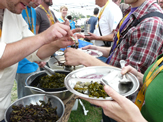
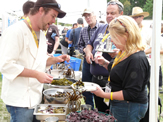
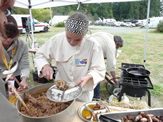
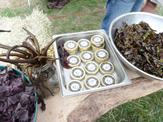
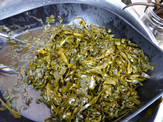
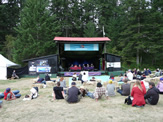
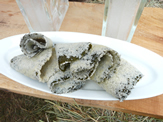
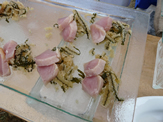
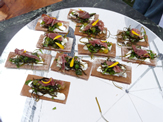
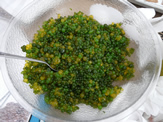

 Accessible Version
Accessible Version